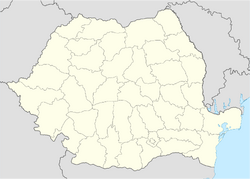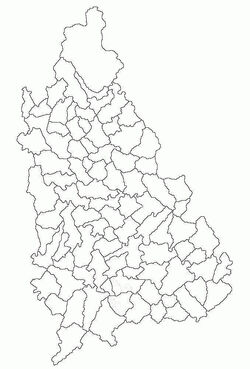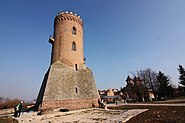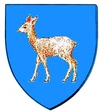| Main | Births etc |
|---|
| Târgoviște | |||
|---|---|---|---|
| — County capital — | |||
| The church of the Dormition of the Mother of God | |||
|
|||
| Location of Târgoviște | |||
| Coordinates: Coordinates: | |||
| Country | |||
| County | |||
| Status | |||
| First mentioned | 1396 | ||
| Subordinated villages | List
|
||
| Government | |||
| • Mayor | Daniel-Cristian Stan (PSD) | ||
| Area | |||
| • Total | 50.60 km2 (19.54 sq mi) | ||
| Elevation | 260 m (850 ft) | ||
| Population (2011) | |||
| • Total | 73 964 | ||
| • Density | 1,461.74/km2 (3,785.9/sq mi) | ||
| Time zone | EET (UTC+2) | ||
| • Summer (DST) | EEST (UTC+3) | ||
| Website | http://www.pmtgv.ro/ | ||
| Târgoviște | |
|---|---|
| Website | http://www.pmtgv.ro/ |
Târgoviște (alternative spelling: Tîrgoviște; Romanian pronunciation: [tɨr.ˈɡo.viʃ.te]) is a city in Romania, being the county seat of the Dâmbovița County. It is situated on the right bank of the Ialomiţa River. At the 2011 census Târgoviște had a population of 73,964, making it the 26th largest city in Romania. One of the most important cities in the history of Wallachia, it was its capital between early 15th century and 16th century.
One village, Priseaca is administered by the city.
Name[]
The name "Târgoviște" is a Slavic name which the city acquired in the Middle Ages. It is derived from the Bulgarian word for marketplace "търговище" (pronounced: [tərˈɡɔviʃtɛ]), referring to the place rather than the market itself, which might suggest that the market (târg) may have at one time been temporarily interrupted.[1]
The name found in placenames not only in South Slavic areas (Bulgarian Търговище and Serbian Trgovište), but also in West Slavic such as Slovakian Trhovište. Additionally, places with the same name are found in Romania, in the regions of Oltenia, Banat, and Moldavia.[1]
The Romanian and a Bulgarian town with the same name are also twinned.

Ascension Cathedral (Catedrala Înălţarea Domnului)
History[]
Early history[]
The area of Târgoviște first inhabited is located where today stand the Saint Nicholas-Geartoglu Church and Stelea Veche Church. It was in this place that the first fortifications had been built: a small stone building surrounded by a brick wall and a moat, probably belonging of a local ruler.[1] However, archaeological evidence is scarce and it's hard to pinpoint exactly in time when this was erected.[1]
Saxon colony[]
Another nucleus of the city was built by Saxon colonists from Transylvania, in the area where the Catholic Saint Mary Church is located, a church that was built during the early years of the colony.[2] A local tradition says that the church was built in 1300.[2] The colonists came around the end of the 13th century and the beginning of the 14th century, the same period that Câmpulung was colonized.[2] There is archeological evidence that the land occupied by the new colonists had been previously inhabited by locals, which leads to the conclusion that it had been approved by the local ruler.[2]
The colonists influenced the local administration, as Târgoviște was the only town in Wallachia that had Transylvanian organization features, having official titles such as birău and folnog, which are found in documents together with local officials, like vornic and pristav.[3] The town had a night watch which was also known by a Latin term (viglu < vigilia) instead of the local terms such pază or strajă.[3]
After 1400, the town began to grow and become denser. Both Saxon part (around the stronghold) and in the Romanian part, there were several large dwellings with cellars and tile stoves similar to those found in Central Europe. The wealth is also known based on the number of treasure troves discovered, the largest being a hoard of 6284 silver coins, found in the Saxon part of the town.[3] The town gravitated around the Saxon part, this being valid until the Saxon community began its decline during the 16th century.[4]
Capital of Wallachia[]
Template:Medieval capitals of Romania In the 14th century, the capital of Wallachia was Curtea de Argeș, however, due to Târgoviște's economic growth, toward the end of the century, it became a secondary residence of the Wallachian hospodar. In 1396, Bavarese traveler Johann Schiltberger mentions both Curtea de Argeș and Târgoviște as capitals of Wallachia.[4] While Mircea I lived in Curtea de Argeș, Michael I, Mircea's son and co-prince lived in Târgoviște, where he continued to live even as a single ruler. Dan II preferred Curtea de Argeș and he was the last hospodar to rule from that city, the court being finally moved to Târgoviște by Alexandru Aldea in 1431.[4]
Throughout the period it was the capital of Wallachia, the Royal Court ("Curtea Domnească") had been constantly refurbished and extended. The compound was surrounded by stone walls and a moat and a new church and a tower had been built.[4] Vlad III Dracula ("the Impaler") later added the Chindia Tower, now a symbol of the city.
Starting with 1465, for the next two centuries, the rulers alternated the capital between Târgoviște and Bucharest, often on political reasons, as the former was preferred by the rulers who were more friendly toward Transylvania and the King of Hungary.[5] Throughout the 15th and 16th centuries, Târgoviște was a major trade hub, especially with Poland, Brașov and Sibiu.[6]
By the 16th century, the Romanians became majority in the city, as some Saxons left for Transylvania and others were assimilated. Greeks merchants began to settle in the city, especially after 1500, while Greek monks settled in the nearby Dealu and Panaghia.[7]
As the capital of Wallachia, Târgoviște faced numerous sieges and invasions. In 1395, it was sieged and set on fire by Bayezid I.[8] In 1457, the townsfolk of Târgoviște were punished by Vlad III Dracula for their involvement in the assassination of his brother: the elite of city was killed, while the young people were sent to work at his Poenari Castle.[8]
The Ottoman invasion of 1462 did not reach the city, being prevented by Vlad III through the The Night Attack. In 1476, the city was taken by Stephen Báthory following a fifteen-day siege intended to restore Vlad to the throne. Several other battles were fought near the city during the rules of Neagoe Basarab and Radu of Afumați.[8]
In 1597, the Hajduks of Mihai Viteazul and Starina Novak fought and won a decisive battle against the Ottoman Empire in Târgoviște.
Decline[]
After the capital was finally moved to Bucharest during the rule of Constantin Brâncoveanu (1688-1714), Târgoviște lost its importance, decaying economically as its population decreased.
Modern history[]
Târgoviște was the site of the trial and execution of Nicolae Ceaușescu and his wife Elena in December 1989.
Geography[]
| Historical population | ||
|---|---|---|
| Year | Pop. | ±% |
| 1500 | 60,000 | — |
| 1900 | 9,400 | −84.3% |
| 1912 | 13,041 | +38.7% |
| 1930 | 22,298 | +71.0% |
| 1948 | 26,038 | +16.8% |
| 1956 | 24,360 | −6.4% |
| 1966 | 29,763 | +22.2% |
| 1977 | 61,254 | +105.8% |
| 1992 | 98,117 | +60.2% |
| 2002 | 89,930 | −8.3% |
| 2011 | 73,964 | −17.8% |
Population[]
In 2011, there were 73964 inhabitants. According to the 2002 census, 96.6% of the inhabitants were Romanians and 2.84% Roma people.
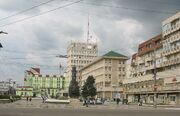
Central square, in front of Dâmbovița county prefecture.
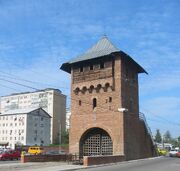
Old Bucharest door.
Transportation[]
Railway[]
The Târgoviște Railway Station is an important railway junction, linking Bucharest from the Ploiești and Pietroșița. Railway station building was inaugurated on 2 January 1884, with rail Titu-Târgoviște. This railway was built by VII Company of the railway of I Engineering Regiment. On 27 May 1894 was inaugurated Târgoviște-Pucioasa railway.
Ploiești-Targoviște was inaugurated on 29 June 1946, although its construction had been started since 1929.
The city is served by Teiș halt, Târgoviște Nord station and the stopping of the Romlux and Valea Voievozilor.
The railway station is open for both passenger traffic - with sales / reservation electronic tickets - and merchandise traffic. Lines serving the large industrial operators of the city - MECHEL, Otelinox, UPET, Erdemir, Romlux, Rondocarton.
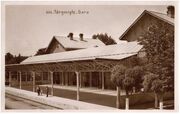
Railway station Targoviste in 1930. The building was inaugurated in 1884.
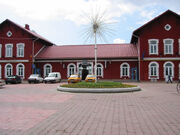
The building of railway station was renovated in 2000-2004.
Roads[]
Located at a crossroads of ancient trade routes, the city is now a road and rail junction, can be easily approached from all sides. Targoviste Municipality is located near the capital of Romania, at a distance of 80 kilometres (50 miles) Otopeni International Airport Henri Coanda, along with the smaller Băneasa Aurel Vlaicu.
| Road number | Cities | |
|---|---|---|
| DN 71 | Tărtăşeşti — Târgovişte — Pucioasa — Sinaia | |
| DN 72 | Găeşti — Târgovişte — Ploieşti | |
| DN 72A | Târgovişte — Câmpulung |
Also, a number of county roads pass the city:
- DJ 711 Târgovişte — Bujoreanca
- DJ 712 Târgovişte — Şotânga — Vulcana-Pandele — Brăneşti — Pucioasa
- DJ 718A Târgovişte — Mănăstirea Dealu
- DJ 719 Târgovişte — Valea Voievozilor
- DJ 721 Târgovişte — Colanu — Văcăreşti — Perşinari — Gura Şutii — Produleşti —Costeşti Deal
Public transport[]
In the city, public transport is provided by SC Public Transport S.A. and include bus, trolley and maxi-taxi. In 2005 was developed and modernized public transport, SC Public Transport S.A. making passenger transport company in public-private partnership.
International relations[]
Twin towns – Sister cities[]
Târgoviște is twinned with:
Sport[]
The city has two football clubs, FC Chindia Târgoviște and FCM Târgoviște, both of which play in Liga III.
Târgovişte is also home to Municipal MCM Târgovişte basketball club which competes in the Romanian League and the EuroCup.
Famous natives[]
- Vasile Atanasiu (1886-1964), general
- Alexandru Brătescu-Voineşti (1868–1946), writer
- Cornel Dinu (1948), football player
- Cosmin Matei (1991), football player
- Adrian Pătulea (1984), football player
- Ion Heliade Rădulescu (1802–1872), writer, philologist, politician
- Laurenţiu Reghecampf (1975), football manager
- Laura Stoica (1967–2006), singer, composer, actress
- Theodor Stolojan (1943), economist, politician
Gallery[]
Notes[]
- ^ a b c d Rădvan, p.295
- ^ a b c d Rădvan, p.296
- ^ a b c Rădvan, p.297
- ^ a b c d Rădvan, p.298
- ^ Rădvan, p.299
- ^ Rădvan, p.299-300
- ^ Rădvan, p.300
- ^ a b c Rădvan, p.302
- ^ "International Contacts". Targovishte Municipality. Archived from the original on 2007-08-13. http://web.archive.org/web/20070813150339/http://targovishte.bg/index_en.php?nav=profile&nav1=99. Retrieved 2013-08-29.
References[]
- Laurenţiu Rădvan, At Europe's Borders: Medieval Towns in the Romanian Principalities, Brill, 2010, ISBN 9789004180109
External links[]
- A presentation of the Medieval Princely Court of Târgovişte - includes 25 contemporary photos, 3 ancient images, 2 layouts, a reconstruction of the Court, bibliography and many other info (in Romanian and in English).
- Museums of Targoviste and of Dambovita county (in Romanian)
- Interactive street map of the city
- City Hall site
| ||||||||

|
Șotânga | Aninoasa | 
| |
| Mănești | Răzvad | |||
 Târgoviște | ||||
| Dragomirești | Ulmi |
| |||||||||||||
| |||||||



